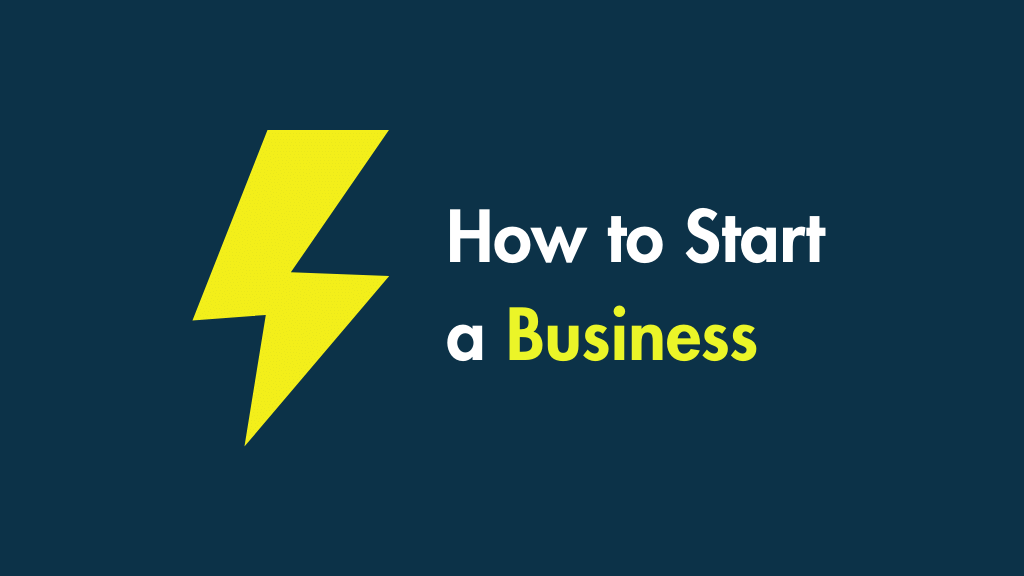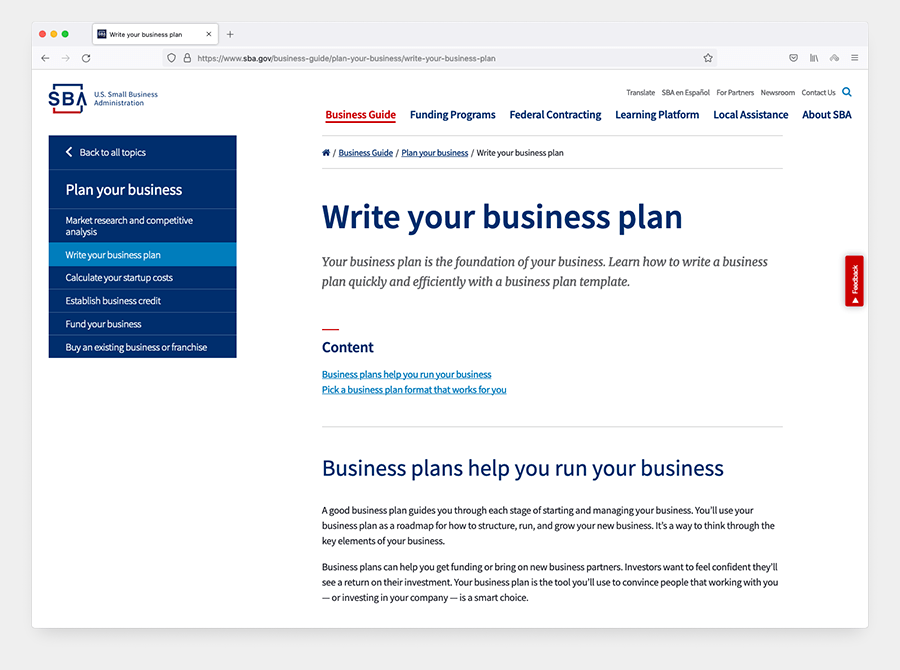
In this checklist for starting a business, I go through all the steps you need to take to get a new venture safely and successfully off the ground.
Introduction
Starting a business can be incredibly rewarding in many ways.
It’s an enjoyable — if sometimes stressful! — creative process that, if successful, can give you a huge amount of independence, free time and financial gain.
These are things that can be impossible to achieve by working in a 9-to-5 job.
But if you’ve never built a business before, it’s very easy to overlook simple things that can mean the difference between success and outright failure.
So, in this post, I’m going to walk you through the key steps to take — and the key pitfalls to avoid — when starting out in business.
Let’s start in by looking at the most important thing: your business idea.

1. Get your business idea right

This may sound obvious, but before you spend any of your money (or anybody else’s) on your business, it’s really important to get your business idea as close to being ‘right’ as possible.
This means ensuring that the core idea behind your business is actually one that will work in the real world — and not just in your head.
So, the key questions to ask yourself are:
- Is my service or product original? (It doesn’t have to be, but it definitely helps!).
- Can I produce my service or product to a standard that will make it stand out above other similar offerings?
- Is my proposition easy to understand?
- Does my product meet a clear need?
- Is there a customer base for my product or service?
- Can I realistically reach that customer base?
To help you answer these questions honestly, it’s always worth reaching out to others in your field — people who may be experts in your industry, or have been in your shoes before.
Not only can this bring you helpful advice and perspectives you may not have previously considered, but you may also find yourself developing a network of contacts that may end up actively supporting your enterprise in lots of useful ways (perhaps even financially helpful ways).
And of course, market analysis is vital — you need to be able to establish that there is an audience for your business idea, and where and how to find it.
Thinking about ‘buyer personas‘ can help here: if you can establish who your ‘ideal’ or ‘typical’ customer is likely to be, you’ll be able to work out if they exist in sufficient quantities to make your business a success, and if you can realistically reach them.
Ultimately, the key thing is to look at your business idea from a wide variety of angles and to keep refining it until it’s truly workable — and bulletproof.
⚠️ Remember: most successful businesses solve a problem
When evaluating your business idea, ask yourself this: will my new business solve a problem?
Think about it: plumbers fix leaks, web designers help people get their businesses online, fast food restaurants give hungry people food quickly.
What problem will your business solve?
The bigger the problem and the better your solution for it, the more likely it is that your business idea is a good one.
Conversely, if your business idea doesn’t solve a problem or meet a clear need, it might be time to rethink it.
Once you’re confident that your business idea is robust and solves a genuine problem for an accessible market, it’s time to look at turning that idea into reality.
Doing this requires you to…
2. Make a business plan

“If you fail to plan, you plan to fail” may be an old saying — but it still rings true.
So, once you’ve settled on your business idea, it’s extremely important to map out exactly how you’re going to make it a success — you need a set of steps you can refer to that will take your business project from conception into something that actually works.
This applies no matter how large or small your ambitions are — regardless of whether you are aiming to be a small business owner or a ‘unicorn’ valued at billions of dollars, you need a plan that gets you from A to B.
Creating a business plan is easier said than done, however! This is because when you’re setting up a business it’s easy to get very excited about the whole thing — this can stop you from looking at things rationally, sequencing key tasks logically, or even writing them down.
There are a couple of ways around this problem; and the first involves business plan templates.
Let’s take a look at these.
Business plan templates
There are lots of business plan templates available online, and these can help you think in a more structured way about how you’re going to set up your business.
The quality of these templates varies considerably however, so it’s a good idea to take a look at a few different ones and ensure that they are:
- well constructed
- well-suited to your business area.
One thing that’s particularly important to do is to make sure that any business plan template you use is suitable for the country you’re operating in.
For example, the types of business entities and laws in the US differ considerably from those in the UK, which in turn differ from those in the EU…so make sure you’re using a document that maps out what you need to do to set up a business in your specific territory.

You’ll need to rely on Google a bit here to source a template that’s right for you — but you’ll usually find fairly reliable business plan templates available from government departments, business groups and charities.
(In the USA, you’ll find some business plan templates on the Small Business Administration website; in the UK the Prince’s Trust website contains some government-approved ones).

‘Brown paper’ planning exercises
Another way to create a business plan is to conduct what’s known as a ‘brown paper exercise.’
This involves getting anyone involved in your new business into the same room and presenting them with a big piece of paper (or board) containing a timeline.
Each stakeholder then writes their key tasks on post-it notes.
A designated project manager then invites all the stakeholders to add their post-it note tasks to the timeline, at the point in proceedings when they think that their task should be completed.

Once everybody’s tasks have been added to the timeline, the project manager goes through them in more detail, and arranges them so that:
- tasks are in an order that could genuinely work
- each task has a realistic deadline
- each task has somebody assigned to it.
The list of tasks and deadlines is then put in an online spreadsheet or project management system (Trello, Monday etc.) and distributed to all stakeholders, who can then refer to it as a to-do list and flag tasks as outstanding, completed etc.
By the end of this process, instead of ending up with a ‘dry’ document, you should have an interactive tool that actively helps all the people involved with your business get it off the ground.
3. Choose your funding model

It’s always tempting to finance a startup by putting your hand in your pocket and investing your own hard-earned cash in it.
This is particularly the case when you’re starting a new business for the very first time — excitement, over-enthusiasm and not having experienced failure before can lead to you putting a lot of your savings into something which is essentially one big experiment.
(Remember: a huge proportion of businesses fail).
So, before you spend your own money on your business, consider the other funding options that might help you cover your startup costs, for example:
- Investors
- Business grants
- Business loans
- Crowdfunding
The other thing to consider is whether you actually need money at the very outset of proceedings. You could consider ‘bootstrapping‘ your business instead — i.e., use your own resources and expertise to kickstart proceedings.
Bootstrapping often works well because lot of new businesses actually need time more than cash. This is particularly the case for digital businesses that rely more on things like coding or content writing — i.e., businesses where knowledge, rather than product inventory, is the driver of revenue. The same goes for consultancy work or legal services.

Some new businesses — particularly digital ones involving coding or content work— won’t always need a huge investment at the outset.
Depending on your skills, you could be the main source of labor for your business until you can afford to hire staff.
The point is that not all businesses need a massive cash injection to get going — provided the business idea is good, and the founder is somebody with the drive to make things happen, an evolutionary process can take place which ultimately generates revenue without an initial capital investment.
That’s not by any means to say that this approach is easy, possible or right for every type of business — but it’s something to think about.
And finally, whatever approach you take to funding, it’s really important to do your sums beforehand.
Make sure that you…
- have a clear understanding of the precise amount of money / time it will take to create the products or services you intend to offer
- research your market and price your product or service appropriately
- carry out realistic profit and loss analysis.
If at all possible, seek professional financial advice when setting up a business — ideally from a financial advisor with specific experience of working with startups, or a government agency that specializes in helping new and small business owners.
If you’re not in a position to do that, try to seek out reputable sources of information online (again, government websites and business support groups can help here).
4. Choose a business name

The name you pick for your business can have a very big impact on its future success — or lack of it. So this is something you need to spend a lot of time thinking about.
Possibly the first thing you need to consider is how limited you want to be by your business’ name.
If you know that your business is always going revolve around a very specific product or service, then there are advantages associated with picking a name that aptly describes it.
As an example of this, consider two ecommerce companies, Shopify and Volusion. They both provide more or less the same thing — a web app that lets people without coding skills build an online store.
But despite being founded seven years earlier than Shopify — way back in 1999, in fact — these days Volusion is just a bit player in the ecommerce market, while Shopify completely dominates it.
There are obviously going to be quite a few reasons for this, encompassing everything from quality of software to investment to marketing strategy — but for me, it’s hard not to conclude that at least some of Shopify’s success is down to the fact that its name explains clearly what the product does: gives you a shop.
‘Volusion’, by contrast, could refer to absolutely anything.
The other advantage of picking a business name that reflects your activities involves search engines. A company can often fare better in search results when its name contains keywords that describe its core offering.
👉 Learn more: Semrush trial details | Semrush review | Semrush vs Ahrefs
Here’s an example of this in action. I once had a client whose company name that described its activities and offering perfectly — and, chiefly because of this, it ranked extremely highly in lots of search results relating to the sort of services it provided.
Business was accordingly good.
The client, however, was keen to embrace a more corporate-sounding acronym as its name — and despite lots of advice to the contrary, decided to change the business name and website domain to reflect this.
The result on search traffic was predictable (and predicted!).

However, there’s also an argument against picking a name that’s too close to what your company is initially going to do.
A lot of businesses evolve over time, starting off selling one type of product but eventually developing another, more successful one. Being tied down to a very prescriptive name can stop you from doing this.
For example, if Jeff Bezos had called his startup ‘OnlineBookshop.com’ rather than ‘Amazon,’ it would have limited his horizons somewhat. Despite its origins as an online book store, Amazon evolved into a hugely profitable general marketplace, selling everything under the sun.
And its name — which wasn’t tied to any particular product or service — allowed it to do that.
So there’s clearly a balance to be struck here — it will depend on the nature of your business and how tied down you want to be to a particular offering.
But however you resolve this dilemma, there a few things that you should always make sure of when settling on a name:
- Try to make your business’ name memorable (without it being too weird!).
- Get feedback on it — take soundings from business associates and potential clients regarding its suitability and ‘catchiness.’
- Ensure that it is not trademarked (by checking with intellectual property rights organisations such as the United States Patent and Trademark Office and the EU’s Intellectual Property Office).
- Even if the business name you settle on is not trademarked, check that there are no businesses operating under it — a quick Google search will help on that front. If there are already organizations using the name, it may be hard to outrank them in search results, and they may take legal action to preserve their use of the name (or try to trademark it restrospectively).
💡Tip: brainstorm with friends and family to come up with catchy name ideas — or bounce existing ideas around with them. Doing so can give you some simple, free perspectives on what works or doesn’t.
There are also quite a lot of online business name generator tools available that can help with this process.
And speaking of trademarks…
5. Register your trademark

Once you’ve settled on a name for your business, make sure you trademark it.
As a bare minimum, this should be done in your main country of operation, although for future-proofing reasons you may wish to register it in other countries too.
You can enlist a lawyer to help you with this, or alternatively register your trademark yourself with the relevant government authority (for example, USPTO in the US, the GOV.UK website in the UK and EUIPO in the EU).
If you have a logo, include that with your trademark registration too.
Because it can be expensive and involve a fair bit of admin, registering a trademark is often one of the most overlooked aspects of setting up a business. But neglecting to do so can cause untold expense and heartache down the road.
⚠️ Watch out for trademark scams!
Because trademark registers are publicly searchable, you may receive scam communications from official sounding organisations asking you for money to complete your trademark registration.
Make sure that you check with a relevant official trademark authority if in any doubt regarding the authenticity of correspondence you receive about your trademark.
6. Register your domain and social media handles

When you’ve settled on a name for your business, it’s important to buy a domain name that includes or reflects it. A huge proportion of business enquiries are driven by search engines — so even if your business mainly provides products and services offline, you are still likely to need a website for it, and by extension, a suitable domain name.
For similar reasons, it’s important to claim appropriate social media handles for your business name too.
Let’s take a quick look at doing both.
Domain name registration
Domain name registration isn’t quite as simple as it might appear; and it’s easy to pick a domain that won’t perform as well as it should.
And if you’re not careful about how you approach domain name registration, your domain — and business — could ultimately be at risk.
Here are a few tips to help you register a domain in the best way:
- Choose the most relevant domain extension for your business
If you are sure you are going to be operating exclusively in one country, it’s usually best to buy a domain for that country (.co.uk, .fr, .ie etc.). The reason for this is that search engines tend to use domain extensions to serve more local results to users. So if, for example, you’re setting up a UK law firm, a domain name of mylawfirm.co.uk would possibly generate more visibility in search results for you than a domain name of mylawfirm.com. Conversely, if you’re going to be operating internationally, a .com domain is usually best. - Register a few related domains
Even if your main domain is going to be mylawfirm.co.uk, it makes sense to protect your brand by registering similar domain names (mylawfirm.com, mylawfirm.net etc.). If you have ambitions to expand internationally one day, you might wish to register your domain using extensions that are appropriate for relevant countries. All this protects you from imposters and also gives you room for manoeuvre in future. - Make sure you set your domain to ‘autorenew’
Given how so many aspects of a business rely on a digital presence these days, if your domain expires, it can destroy your entire enterprise. Most domain registrars give you the option to set your domain to autorenew, thus minimizing the risk of it expiring through neglect. Make sure you avail of this option! - Lock your domain
Domain name providers also give you the option to ‘lock’ your domain — use it, as this protects it against unauthorized changes. - Use a reputable provider
Use a well-known registrar to register your domain — and one that lets you log in with two factor authentication (this helps to keep your domain safe). - Keep your domain and hosting separate
Although a lot of services encourage you to use them to both register a domain and host your site with them, it’s safer to keep the two things separate. This is because if you get locked out of your hosting account, or it got hacked, you’d still be able to access your domain (and reinstate your website at the same web address with another hosting provider).
Social media handles
When you set up profile on a social network, you are usually given the option to customize its URL so that it includes your business name — for example, you might set up a Twitter URL along the lines of www.twitter.com/mycompanyname.
The bit at the end (‘mycompanyname’) is your social media ‘handle.’
Once you’ve settled on a business name, it makes sense to claim all your handles as soon as you can. This lets you protect your brand on social media and maximize visibility for it.

(Note however that some social networks will require you to reach a certain number of followers before allowing you to do that.)
Once you’ve got your domains and social media handles ready, it’s time to think about the legal structure you’d like to choose for your business.
Let’s go through this now.
7. Choose a legal structure

Please note that none of the below constitutes legal advice — when setting up a business it is always best to consult a professional lawyer regarding the legal aspects of doing so.
The type of legal structure you choose for your business can have a LOT of ramifications for the way you do business, the sort of taxes and rates you can expect to face, and — crucially — how exposed you are to risk.
The precise legal structures available to businesses vary significantly by country, but in general you will usually end up deciding between operating as a ‘sole proprietor’ (or ‘sole trader’) and some form of limited liability company.
It’s generally easier to set up using a sole proprietorship / sole trader model — there’s usually less paperwork involved, and the accounting is simpler.
However there can be significant advantages to running your business as a limited liability company — mainly because of the ‘limited liability’ part.
With a limited liability company, if you do something wrong, and your company gets sued, you’re not personally liable, and your savings and house aren’t on the line. Your company might end up bankrupt — but not you personally. You will still have a roof over your head!
Additionally, you may find that there are certain tax benefits to operating as a corporation rather than an individual, or grants and schemes open to you. These will vary by country and will require you to do some research (and number crunching).
My own personal preference is for incorporation — simply because this structure separates your personal life from your business more neatly, and usually affords you more financial protection in the case of something going catastrophically wrong.
For advice on incorporation in the United States, check out the the Small Business Administration’s guide to the topic; UK readers will find the Companies’ House guide to incorporation useful.
Don’t miss out on our free Business Growth E-Kit
For a limited time only, we’re offering our readers some excellent free tools to help them grow their business. Sign up free to immediately receive:
- downloadable cheatsheets on how to grow an online business
- an exclusive discount code for email marketing app GetResponse
- a 30-day free trial of Canva Pro
- extended free trials of essential growth-hacking apps
- ongoing free tips and advice on digital marketing
We respect your privacy, and you can unsubscribe any time. View privacy notice.
8. Register your business with the relevant authorities

Depending on the country or state you live in, you’ll have to register your new business with a variety of different authorities – this is especially the case if you intend to incorporate your business.
Additionally, depending on the area you’re working in, you may find that you need to register your business with industry-specific professional bodies (particularly if you are operating in the food, health or social care sectors).
If processing personal data — which most businesses will do once they add a ‘join my mailing list’ form to their site — you may also need to register your business with a data protection authority.
This is particularly relevant to businesses operating in EU countries — where General Data Protection Regulation (GDPR) laws now place strict requirements on business owners regarding the processing of personal data — and also in California, where the California Consumer Privacy Act (CCPA) does similar.
By registering your business in the right way and with the right bodies, you are more likely to avoid any legal problems relating to your business in future.
And doing so can actually help increase the overall visibility of your business. Registering a company with the relevant authorities and agencies — and ensuring you have an employer identification number or company registration number — often means that it will be listed on a variety of trusted online directories and websites. These can help can point customers your way, or give your business credibility.

9. Sort out your business operations

At this point in proceedings, many of the foundations of your business will be in place – you’ll have a business idea, name, trademark, legal structure and so on.
But unless you’ve been extremely organized, or had a lot of foresight, you may not have thought too much about business operations.
Business operations are the ‘nuts and bolts’ of a business — the exact processes that keep it running and making money. And, rather than making these up as you go along, it’s better to have a clear idea of how you are going to operate your business before you start trading.
Things you’ll typically need to consider on this front are:
- Business location — where should you operate? Do you need any office or retail space?
- Staffing — do you need a team, or can you operate on your own initially?
- Business accounts – who are you going to bank with? How are you going to structure your accounting systems and manage cash flow? Who is going to have access to your company bank account? Do you need company credit cards?
- Legal obligations — are you aware of all the legal requirements relating to your business type? Have you got all the right licenses in place? Have you got a sales tax permit? Are you meeting data protection laws?
- Equipment — what sort of computers will you use? Macs, PCs or Chromebooks? What other items of equipment are key to the smooth running of your new business?
- Software — what operating system will you use? Which accounting software is best for managing your business finances? Which apps will you invest in? Can you drive efficiencies by using AI tools like ChatGPT?
- Delivery methodology – how exactly are you going to fulfil your services / products?
- Cyber security — how will you keep your business safe online?
- Data capture — what data do you need to capture from your customers? How are you going to do this?
- Data protection — are you capturing data legally? Have you registered with an information commissioner (or similar data protection authority)?
In essence, with operations, you are designing the ‘engine’ for your business.
Accordingly, it makes sense to create an operations plan and to refer to it as you proceed with your venture (flowcharts can work well here).
An inventory of all the ‘parts’ you need to make that plan work is important too.

Now, you might think that all this sounds a bit like creating another business plan — and indeed, some business plans do have sections dedicated to operations.
However, while business plans tend to outline a business strategy in broad terms, an operations plan is more about the day-to-day running of a business, and is much more precise about what should happen, where, and when — and who is responsible if things go wrong.
It can cover everything from Key Performance Indicators (KPIs) to risk assessment to who makes the coffee — and the better the operations plan, the more likely you’ll be able to hit the ground running when you open your business’ doors.
At the end of the day, you should aim to end up with several operations plans — or ‘standard operating procedures‘ (‘SOPs‘) — that detail exactly how each strand of your business works.
Not only will this make your business much easier to run, it will also make it easier to sell (as a potential new owner will be able to to get a very clear picture of current operations, plus instructions on how to keep things going smoothly after a purchase).
And, if your business grows, you’ll find that operations plans become especially helpful — if you take on new staff, they’ll be able to refer to them to get an instant overview of how your business works and how they fit into proceedings.
10. Create your brand

So far, we’ve looked at quite a lot of the ‘dry’ (okay, boring!) elements of setting up a business — but now now it’s time to get creative, and establish a brand for it.
Creating a brand can be fun — but it’s also something you need to take very seriously, because establishing a strong business identity is essential for establishing trust between you and your potential customers. No matter how good your products or services are, if they are presented in a homespun way, you will struggle to generate sales for them.

To design a brand, it’s a good idea work with a graphic designer to compile a set of detailed brand guidelines.
These should define:
- what your logo looks like
- what color palette is used across all your materials (and in which contexts)
- what sort of photographs are used in your marketing material
- what typefaces should be used.
It’s tempting to make these up as you go along, but it’s really important to define brand guidelines before you start creating things like websites, social media profiles, stationery and so on.
Having a set of brand guidelines designed by a professional graphic designer takes the guesswork out of things, gives you more impressive visual results and lets you create all your print and digital assets much faster.
If in the early days of your business you can’t afford a graphic designer, a tool like Canva, which aims to provide non-design professionals with a means to create brands and high-quality designs, can really help here.
You can learn more about this product in our Canva review, our ‘What is Canva?’ article or our Canva pricing guide.
And speaking of tools…
11. Pick the right digital tools

There have been quite a few references in this post to the importance of getting things right from a digital perspective.
That’s because in 2024, it’s hard to think of any businesses (even local ones) that can flourish without a strong digital presence.
Now, a lot of startups equate ‘going digital’ with having a Facebook page or a TikTok profile — and yes, social media is important, particularly for generating word-of-mouth business.
But perhaps more important — and certainly more overlooked — are creating a really good website and building your own mailing list.
Let’s take a look at how to do both.
Creating a website
A good website is important because:
- it gives you more visibility in search results (Google typically gives websites priority over social media pages in search results, and you can optimize websites far more extensively for search engines than you can social profiles)
- it lends credibility to your business (people are far more likely to trust a business with an official website than one without)
- it can provide functionality that enhances what you are doing offline (data capture, bookings, subscriptions, vouchers, online product sales etc.).
When building a website, there are generally speaking two options available to you: hiring somebody to build it on your behalf, or using a DIY website builder tool. There are pros and cons to both approaches.
If you are absolutely terrified by the prospect of putting a website together, or if you need a website that requires very bespoke functionality, then commissioning a web developer is usually a good bet.
Many businesses opt for WordPress in this context, as it is a platform that you can build just about any type of website with, and it can be configured in sophisticated ways that can aid visibility in search engines.
The downside of this approach is that depending on the scale of the project, a significant budget may be required; and a lot of startups don’t have much cash. If you’re in that boat, a DIY website builder can help.
We generally recommend three tools, depending on context.
For businesses that need a general website (a brochure, portfolio etc.), along with some basic e-commerce features on the side, it’s hard to argue with Squarespace, which comes with some lovely templates and is very easy to use.
You can check out our Squarespace review here.
📚 Related resource: Wix vs Shopify vs Squarespace — The Essential Guide
Businesses that need an online store might also wish to look at hosted store builders like Shopify or BigCommerce; there’s also the option of selling on existing online marketplaces like Amazon and Etsy.
Shopify is probably the web’s most popular online store building solution, is easy to use, and is the platform of choice for millions of companies worldwide.
For more information about the platform, you might like to read our comprehensive Shopify review or our Shopify store setup guide.
And you can learn more about its free trial here.
BigCommerce is not as well-known as Shopify, but offers more built-in features than it (Shopify often requires you to pay for ‘add-ons’ to get additional functionality). It’s also particularly good for those who need to sell goods in multiple countries or in multiple currencies.
You can read our BigCommerce review here or check out our BigCommerce and Shopify comparison here.
Using platforms like Etsy, eBay and Amazon to sell online involves a different approach to e-commerce — but one that can work very well for certain businesses. You can check out our Shopify vs Etsy post, our Shopify vs eBay shootout or our Shopify vs Amazon comparison review for more details on how to use these marketplaces effectively when starting a new business.
Building a mailing list
In my experience, a mailing list is possibly one of the most impactful marketing assets a business can have.
A good list gives you an incredibly cheap, direct way to communicate with your warmest leads — in a way that is unfiltered by social media or search engine algorithms.
You send a message about a product or service, it lands in an inbox — and if people are interested enough, they’ll buy.
However it’s important to note that growing your email list and sending e-newsletters is not simply a case of storing a bunch of email addresses in a spreadsheet and copying and pasting them into an Outlook message.

To do email marketing right you’ll need a dedicated service — there are many available, but our preferred one is GetResponse.
This is because it doesn’t just provide email marketing but also lets you run webinars and create automated sales funnels — check out our GetResponse review for more details.

Other services you can consider include AWeber or Mailchimp, which also offer a lot of sophisticated email marketing features.
Whatever service you choose, there are variety of steps you’ll need to take to build a mailing list that helps your business grow — you can read more about these in our guide to creating an effective e-newsletter and email marketing strategy, or watch the video below for a ‘quick start’ guide on the topic.
Finally, in addition to a website and an email marketing solution, you’re going to need some other digital tools to get your startup off the ground.
The key thing you’ll need is a productivity suite: Google Workspace and Microsoft 365 are usually the obvious choices here (you can check out our Workspace vs 365 comparison here, our Google Workspace review here, and our Microsoft 365 review here).
You’ll also need to consider things like CRM tools; SEO tools like Ahrefs or Semrush; project management apps; social media management tools; accounting apps and others.
Check out our rundown of the 10 key apps for startups for some suggestions on all these.
Once you’ve got your digital tools sorted out, it’s time to think about your team.
12. Pick the right team

Depending on your finances, you may be in the fortunate position of being able to hire some people to work with you as you get your business off the ground.
Before you do that however, you should ensure that you absolutely do need to employ people in the very first phase of your business.
As discussed earlier, certain business types don’t necessarily need much labor at the very outset — particularly online businesses or consultancy services — and the cash might be better spent elsewhere.

If you do definitely need to hire staff, here are a few pointers on doing so:
- Don’t get too fixated on finding the ‘perfect’ candidate for a role. Yes, experience and qualifications are important, but a team member’s enthusiasm and adaptability go a long way when you’re relying on them to help you set up a new venture.
- Don’t be a cheapskate when it comes to wages. Not only will this make it harder to find good candidates, but if you hire somebody that’s a great fit for your business and then proceed to pay them an uncompetitive salary, you’ll dampen their enthusiasm for the role and they probably won’t hang about long.
- Look beyond LinkedIn when recruiting. Your local area is likely to have a lot of social media groups for freelancers and jobseekers, and you may find that once you post a job on these, word about it spreads like wildfire. Facebook also has its own jobs board, which is free to use.
- Be creative about working arrangements — particularly in a post-Covid era, many prospective employees will have expectations that working from home, using flexible working hours, will be a possibility. If you can at all facilitate this, do — you’ll encounter a much wider range of candidates (and good ones) as a result. And you’ll end up with a happier team too!
- Do things by the book. Avoid the temptation to pay ‘cash in hand’ or avoid paying relevant employee taxes and contributions. The ramifications for this sort of approach can be serious — if you get caught out, any economies made by cutting corners will be false ones.
- Remember all the legal and financial obligations of hiring staff — in the US, that means things like sorting out employer identification numbers; in the UK, you’ll need to think about national insurance, PAYE issues and so on. As always, when in doubt, get professional advice.
One last thing to remember about picking a team is this: even if you’re not hiring people, it’s still possible to build and nourish a supportive group of individuals who get right behind your business and help it grow.
Friends and business associates can become important sources of confidence and mentorship (and if they like you enough, may even bless you with a bit of free work!).
So, involve your community as much as you can when setting up your business — let them know about what you’re doing, reach out for advice, and ask for support whenever you can. You’ll be amazed at how people can get behind you and help build momentum for your new venture.

13. Insure your business

A lot of new business owners are very aware of the financial risk of not making a profit — but they often neglect the other sorts of risks that are involved with startups.
What happens if somebody seriously injures themselves on your premises?
Or if somebody installs ransomware on your website?
Or you publish content that libels somebody?
Or if your warehouses get flooded?
There are a wide range of scenarios that can have disastrous consequences for a business and its finances — and accordingly, it makes a whole lot of sense to get insurance that covers them.
The types of insurance you’ll need will vary according to your business type, but key ones to consider include:
- Public liability insurance — this covers you if somebody makes a claim against your business relating to injury or property damage.
- Professional indemnity insurance (also known as professional liability insurance) — this can compensate your business if it is being sued by a client for making an error that leads to financial loss.
- Cyber insurance — this can protect your business from digital threats such as data breaches or hacks.
14. Launch it!

I’ve now outlined a series of tasks which tick off a variety of conceptual, administrative, legal and operational boxes for your new venture.
But the day will eventually come when it’s time to take a deep breath and launch your business. This will involve creating a marketing plan that turns your business idea from something that lives in your head — or perhaps on paper — into something real and tangible.
Typically, this involves communicating the existence of your business on a variety of channels. The key ones to consider are:
- Word of mouth: conversations with friends and business contacts can go a long way in driving awareness of a new business. Make a list of every personal contact you have who might be able to support you, and let them know exactly when your business is launching — and how they can help.
- Social media: local Facebook groups can be a great way to announce a new business, particularly if it’s one that serves a very particular geographical area. And of course your own social media profiles are a good place to share news of your launch too.
- SEO: Search engine optimization is absolutely key to the success of a business — make sure you familiarize yourself with the basics of SEO and do your utmost to ensure that your site, products and services are all visible on search engines before you launch your business. If your business involves a physical store that serves customers in a particular geographic area, pay particular attention to local SEO.
- Online ads: Facebook and Google ads can provide a quick and highly targeted way to generate a lot of awareness of your new business, and visits to your website.
- Content: blogging can be an incredibly effective way to establish yourself as an ‘thought leader’ in a particular field — and when done well it can also generate a lot of sales for your business. (Our guide to increasing your blog traffic explains how).
It’s important to structure all this in a coherent fashion though — accordingly, it’s a good idea to put together a timeline for your activities and create a content matrix containing all the text and images you’ll need to compile for your marketing campaign.
Again, a ‘brown paper exercise’ — as discussed above in the section about creating a business plan — can help with this.
Wrapping up
I do hope that you’ve found our checklist for starting a business useful — and that it’s given you a good overview of what a starting new venture actually entails!
Please do feel free to leave any questions in the comments section below — we read them all and will do our absolute best to answer any queries you may have about getting a successful business off the ground.
I’ll leave you with a cheatsheet of the key things you need to do to start a business.
How to start a business — cheatsheet
- Make sure your business idea is robust
Find a business idea that solves a problem and road-test it to destruction before settling on it. Conduct market research to prove to yourself that your business concept can really work. - Create a strong business plan
You can use a business plan template or a ‘brown paper exercise’ to help you structure how you’re going to get your business off the ground. - Choose a funding model
Work out whether you are going to finance things yourself, rely on investors or try to get things going without cash. - Pick a good name for your business
Make it memorable, decide how closely it should match your activities and check nobody else is already using it. - Trademark your business name
As a bare minimum, trademark your business in your main country of operation, but think about whether you should register a trademark in other territories too. - Register a domain name and social media handles
Use a reputable provider for your domain name, lock it and set it to autorenew. - Decide upon a legal structure for your business
This will usually boil down to a choice between operating as a sole proprietor or a limited liability company. The advantage of the latter is that you avoid personal liability for errors in your work — which is much safer from a financial point of view. - Register your business
This will typically involve notifying relevant government authorities, professional bodies and data protection offices about your business and its activities. Ensure that you are aware of any relevant business regulations (and if US-based, remember that these will apply at both state and federal level). - Sort out the operations
Create ‘nuts and bolts’ standard operating procedures (SOPs) that spell out precisely how your business will run on a day-to-day basis. - Create your brand
Work with an experienced graphic designer to create brand guidelines and a logo. This will help you achieve more professional visuals for your business and generate trust between you and your potential clients. - Get the right digital tools
As a bare minimum you’ll need to create a good website and a strong mailing list. - Pick a good team
This may mean hiring staff to work for you, or identifying people in your community who can get behind you in other ways. Remember that either way, enthusiasm is key. - Get insurance
The type you will need will depend on your type of business, but most would be advised to get professional indemnity, public liability and cyber insurance policies. - Create a launch plan
Identify the marketing channels you want to use to promote your business, and create a structured plan regarding how you do so.
Comments (2)
This is a fantastic resource – thank you! After a long career in the private and public sectors I am branching out on my own, and this is a very helpful next step. Concise, to the point, approachable.
Thanks Rob – appreciate the feedback and very glad you found the guide helpful!